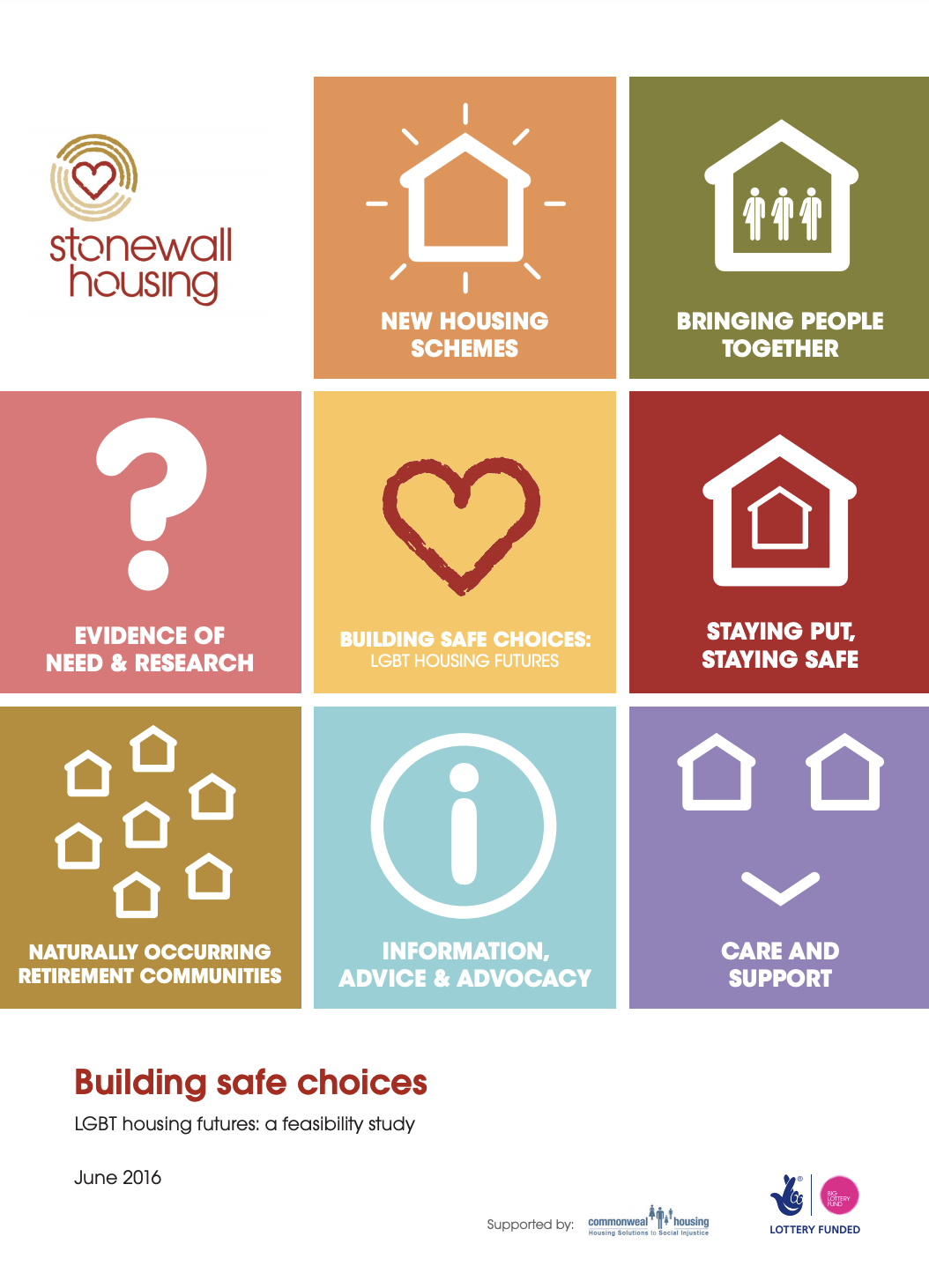2016 REPORT
LGBT housing futures: a feasibility study
The right care for you
Older LGBT people’s housing cannot be looked at without taking care and support into consideration, whether it’s about finding good quality, appropriate care, or having to move in order to access these services.
At the moment, there is no simple answer as to how older LGBT people can access the most appropriate care and support. There are, however, reports of older LGBT people having to go back into the closet in order to be admitted to care homes, or being denied admission to care homes because of their sexuality.
There are no existing extra care schemes with a focus on older LGBT residents. The same is true of care homes. When organisations do have a proactive approach to meeting LGBT needs, this should be identified by regulators, and can then feature in the relevant scheme’s publicity. In 2015, a Care Quality Commission report on a care home stated:
Anchor Trust had a group which lesbian, gay, bi-sexual and transgender (LGBT) people were invited to join. A poster about the group expressed the organisation’s commitment to providing services which were welcoming and inclusive.
The message this sends to prospective LGBT residents is clear. Yet it is impossible to know whether this approach is as a result of individual staff at the home, or as a result of an organisation-wide policy.
A mark to trust
In theory, you should be able to choose the care service that meets your needs. The reality, though, is that care is usually provided as part of a care home’s package. If, as an individual, you need to choose a care provider – after, for example, a fall or illness or hospital admission – then you primary concern tends to be about your immediate health needs, rather than your needs because of your sexuality or gender identity.
What’s needed is some sort of quality assurance that can give customers the confidence that the care providers they’re thinking of choosing are LGBT aware and able to meet their specific needs.
Stonewall Housing, along with partners, is developing a charter mark scheme aimed at organisations who work with older people, including housing providers and care and support providers.
The charter mark consists of three parts:
- an initial audit of services to see what the providers are already doing, and whether their services are LGBT inclusive;
- training for staff teams to increase awareness;
- a second audit after the training to see what has changed.
Our idea is for the training to be delivered by community members who have completed one of our training for trainers courses. Thanks to funding from Comic Relief, and working alongside Age Concern Lancashire, we have developed a number of resources. If you’re interested in these, or in attending a training for trainers course, contact Tina at Stonewall Housing.

With 1 in 3 of the LGBT community as a whole having an impairment, compared to 1 in 4 of the general population, and LGBT people being more likely to live away from the area they grew up and less likely to have close family relationships or children, disabled LGBT people of all ages form a very large potential market for care and support services. It’s a great shame that, at best, providers advertise themselves as offering care ‘regardless of’ sexual orientation and gender, whereas LGBT disabled people want all support delivered to them with due regard for these aspects of our lives and identities.
The care and support services that help people stay in their home are probably the same as anyone else. There are probably dimensions of an individual’s life that are specifically related to the sexual orientation and gender identity that need to be provided for, but I suspect that the vast major of things are relatively the same for all people as they age and it is the need for personalisation that should drive delivery and creates choice. Isolation is a key issue for many people as they age and this can be a particular issue for people who may not have children or grandchildren to rely on. This can best be addressed through supporting people to reach out and engage in wider networks. Help to do this (physically and financially) has a huge impact on wellbeing.
With regards to individuals coming together to pool funds in order to purchase good quality LGBT care, I have lots of experience in this having piloted such models in care and support with a range of people in a range of ways. Key learning is:
– needs to be co-produced, otherwise it doesn’t work
– People more happy to purchase collectively when it is not personal care. Things such as leisure activities work well as a good starting point to share things with low risk
– Needs facilitation and an infrastructure to support
– Things such as collectively purchasing night cover worked well, but day support was individually purchased. Can be done but is really difficult and needs a lot of confidence building to happen.
LGBT+ community support : People should have links to local LGBT+ or LGBT+ friendly services. This could include befriending services and other groups as well as LGBT+ venues and events.
Geographical community support : Accessible community amenities, a range of friendly services which encourage LGBT+ people to engage with their community and thus reduce isolation e.g. libraries, coffee shops, walking groups, tai chi classes, adult education, etc.
Health care : Good primary care services as well as a range of other options to support people in their homes.
Well designed and adaptable homes : For people to be able to continue to live at home with complex health issues.